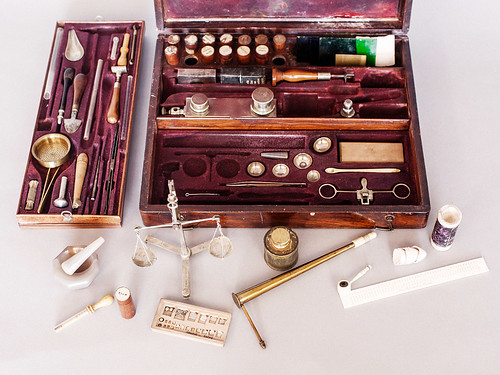
PREV ARTICLE
NEXT ARTICLE
FULL ISSUE
PREV FULL ISSUE
THE ASSAYER'S BLOWPIPE
While not numismatic, this article deals with the mechanics of assaying ore in the late 1800s. Tricky process! Interesting.
-Editor

Pretend for a minute that it’s 1875 and you’re a mining engineer whose job it is to figure out how much gold is in them thar hills. Get it wrong, and your company is going to waste a lot of time and money hunting for gold that’s not there—or worse yet, miss out on the mother lode. Not to worry, though, you’ve totally got this. You grab your trusty blowpipe kit, much like the gorgeous set above, and get to work. Blowpipes have been used for centuries to identify which elements are present in a mineral sample, says William Jensen, an emeritus chemistry professor at the University of Cincinnati. In fact, Jensen says, blowpipes were used in the original discoveries of about a dozen elements, from nickel (in 1751) to indium (in 1863). This kit, produced around 1870, could be used for that type of analysis, but it could also be used to figure out how much of a particular element was in a sample of ore. Portable kits like this were first developed in the 1830s at the Freiberg Mining Academy in Germany, Jensen says. “These kits would allow someone to set up a table and do the assay right at the mine site instead of taking samples back to the lab.” The secret to the blowpipe is the intense heat it created. Here’s how it worked: First you’d chip off a small sample of ore and weigh it with the scale (visible just in front of the case). Then you’d combine the ore with some tiny lead pellets in a scorification dish (those are the little clay dishes inside the front part of the case), and heat the whole thing with the alcohol lamp (the silver object in the middle of the case with two round caps—one for the wick and one for adding fuel). This is where the blowpipe comes in. It’s the long L-shaped brass object with the white ivory mouthpiece in front of the case. By exhaling steadily through the blowpipe (never inhale!), you add oxygen to the flame that can increase the temperature above 2,000 degrees Celsius (3,632 degrees Fahrenheit). “You’re huffing and puffing because you’ve got to keep that airflow constant,” Jensen said. There’s a trick to blowing through puffed out cheeks while simultaneously inhaling more air through your nose to keep the flow going, Jensen says. At that point, some of the lead would oxidize and react with any silicates in the ore to produce a glass-like substance called slag, and the rest of the lead would form an alloy with any gold or silver in the sample. You’d end up with a tiny chunk of glass and a tiny bead of metal alloy.
To read the complete article, see:
The Strange Blowpipe 19th Century Miners Used to Analyze Ore
(www.wired.com/2014/08/crazy-blowpipe-apparatus/)
The Numismatic Bibliomania Society is a non-profit organization promoting numismatic literature. See our web site at coinbooks.org. To submit items for publication in The E-Sylum, write to the Editor at this address: whomren@gmail.com To subscribe go to: https://my.binhost.com/lists/listinfo/esylum All Rights Reserved. NBS Home Page Contact the NBS webmaster 
|